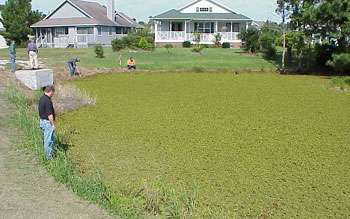
The merits of certain aquatic weeds, such as hydrilla, are often debated among fishermen, biologists and water managers. However, the weedy subject of this article should draw unanimous agreement. Giant salvinia is considered one of the worst aquatic weeds in the world and has become established in Alabama, Arizona, California, Florida, Georgia, Hawaii, Louisiana, Mississippi, North Carolina, Texas and Virginia in recent years. It will likely continue to spread causing environmental damage as it goes.
Giant salvinia is actually a fern without true roots, although it does have a modified leaf that resembles roots and functions as a root system. These “roots” do not attach to sediment so the plants free-float along with water currents. Giant salvinia typically has a distinct appearance from other free-floating plants. The foliage is extremely hairy and the hairs actually resemble egg-beaters if viewed under low magnification. Leaves will initially be spread out on the water surface, but will compress together as mats become denser and thicker. This plant will produce flowers.
Giant salvinia has one of the fastest documented growth rates among plants. Under perfect conditions, plant biomass can double in less than three days. This means that if a 10,000 acre lake were contaminated with four square inches of plant material, the entire lake could be covered in approximately 100 days. As salvinia spreads across a water body, it also forms dense mats that can be over 3 feet in thickness. These mats reduce oxygen in the water by preventing oxygen movement from air to water while decomposing vegetation removes oxygen already in the water. As a result, dissolved oxygen in the water drops well below levels needed to support fish. In addition, shading from the mats prevents growth of submersed aquatic vegetation causing further environmental damage.
Giant salvinia is regulated as a federal noxious weed. This means that interstate transport, sale or exchange is illegal. Many states also regulate this species as a noxious weed, thus prohibiting intrastate propagation, sale or transport. These regulations, however, are not perfect in preventing spread of this plant. As giant salvinia does not produce viable spores (seeds), the only method of spread is through plant fragments. These fragments can become entangled in boat props, trailers and other equipment and be transported along with those items. Spread has also occurred through the aquarium and water garden trade. It has occasionally been sold or traded as a novelty, but more frequently contaminates other aquatic nursery plants and is transported unnoticed.
The most effective management tool for salvinia control is prevention, so exercise caution to prevent the spread of this invasive species and report new infestations early. Once established, control options are generally limited to insect biological control and herbicides. Both of these options can effectively control or suppress salvinia, but eradication from water bodies is extremely difficult.




